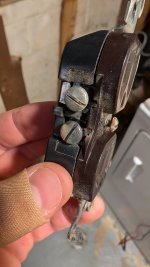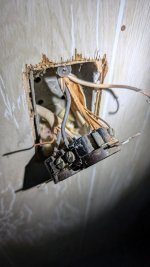MechEdetour
Member
- Location
- NY, USA
- Occupation
- Design Engineer
Not sure where on the forum this is appropriate to post, but thought some folks here would find this interesting. I've always heard about the hazards of arcing due to loose wire terminations, but it always came off as a "it wouldn't happen to me" type of situation. Well, that wasn't the case this weekend!
My hot water tank sprung a leak this weekend so I went about replacing it. Unrelated to the hot water tank, I went to plug in the shop vac to clean up some debris off the floor and right after I plugged it in I saw what looked like some arcing behind the faceplate. Even after I unplugged it, the arcing continued! I pulled off the faceplate to see what was arcing and took a quick video of it. Seems like any movement of the receptacle triggered the arcing (it was after I removed it that I realized the loose termination). Pretty amazing how it continued to restrike.
Please forgive me in advance for filming in portrait mode...
It's an old receptacle. If I had to guess the original one that came with the house. House was built in 1980. I don't think the terminal screw loosened up on it's own either. I think it just wasn't torqued down properly when installed. I am constantly finding suspect workmanship in this house - I always joke that someone's uncle built it.

Kind of like this... notice how the EGC for one of the circuits isn't even bonded to the receptacle. I think this is the 5th or 6th time I've come across this in my house (seen it in switches, light fixtures, and receptacles like this one). Anyways, not why I made this thread.

I guess if I wanted to come out of this event with a better understanding of something, I would like to know why the neutral would restrike like this even though there was no load. Before I looked into it I thought it'd be the hot wire that was arcing, but that wasn't the case. So why was the neutral arcing, and why was it arcing with no load? Seems like the "arcing circuit" was taking place between the two neutrals terminated to the receptacle.
Either way, I know I'm walking a fine line discussing this on the forum - just want to make it clear I am not here for any DIY advice. Just sharing an incident involving arcing in a residential receptacle, and trying to understand *why* or *what* would cause the neutral to arc as such.
My hot water tank sprung a leak this weekend so I went about replacing it. Unrelated to the hot water tank, I went to plug in the shop vac to clean up some debris off the floor and right after I plugged it in I saw what looked like some arcing behind the faceplate. Even after I unplugged it, the arcing continued! I pulled off the faceplate to see what was arcing and took a quick video of it. Seems like any movement of the receptacle triggered the arcing (it was after I removed it that I realized the loose termination). Pretty amazing how it continued to restrike.
Please forgive me in advance for filming in portrait mode...
It's an old receptacle. If I had to guess the original one that came with the house. House was built in 1980. I don't think the terminal screw loosened up on it's own either. I think it just wasn't torqued down properly when installed. I am constantly finding suspect workmanship in this house - I always joke that someone's uncle built it.

Kind of like this... notice how the EGC for one of the circuits isn't even bonded to the receptacle. I think this is the 5th or 6th time I've come across this in my house (seen it in switches, light fixtures, and receptacles like this one). Anyways, not why I made this thread.

I guess if I wanted to come out of this event with a better understanding of something, I would like to know why the neutral would restrike like this even though there was no load. Before I looked into it I thought it'd be the hot wire that was arcing, but that wasn't the case. So why was the neutral arcing, and why was it arcing with no load? Seems like the "arcing circuit" was taking place between the two neutrals terminated to the receptacle.
Either way, I know I'm walking a fine line discussing this on the forum - just want to make it clear I am not here for any DIY advice. Just sharing an incident involving arcing in a residential receptacle, and trying to understand *why* or *what* would cause the neutral to arc as such.
